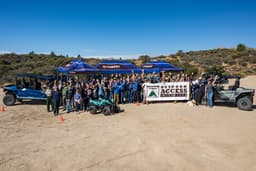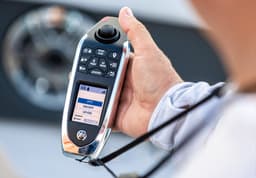
MOTOROiD's Evolutionary Path to Explore New Human-Machine Relationships

Yamaha Announces Thrilling New YZF-R7 AND All-New Adventure-Ready WR125R Dual Sport
November 4, 2025
Yamaha WaveRunners Rack Up 25 Podiums at IJSBA World Finals
October 28, 2025
Yamaha Outdoor Access Initiative Celebrates National Public Lands Day by Completing Employee Volunteer Trail Workdays in California and Georgia
October 8, 2025
Yamaha Marine wins innovation award for Helm Master Ex wireless control system
October 7, 2025
Yamaha Unveils 2026 Side-by-Side Vehicles: Proven Off-Road Excellence
September 10, 2025
Yamaha Announces 2026 ATV Lineup
September 10, 2025MOTOROiD 2: A Significant Update Focusing on Interactions between People and Their Machines
What will human–machine interfaces of the future actually be like? The original MOTOROiD is a proof-of-concept experimental electric motorcycle integrating mobility with intelligent technologies. If people and their machines can take on a deeper kind of partnership, one where they can call to and respond to one another, a yet undiscovered kind of Jin-Ki Kanno is sure to emerge. In this issue, we introduce the MOTOROiD 2 that was unveiled at the Japan Mobility Show 2023, while touching on the possible evolutionary directions for personal mobility.
Exploring the Depths of the Human–Machine Relationship
The first MOTOROiD was unveiled in 2017 as a proof-of-concept machine and its developers sought new forms of personal mobility in which the rider resonates harmoniously with the machine. Equipped for high-precision balance control via artificial intelligence and autonomous technology, it can sense its own state and adjust its center of gravity accordingly to stand up off its kickstand and remain upright unassisted. Furthermore, it can recognize its owner and move forward to meet them as well as several other actions, and the lifelike feel of its motions inevitably leads those who see it in action to envision a new relationship between people and machines.
If the human–machine relationship can be taken deeper to a level where both respond to each other like partners, a Jin-Ki Kanno*1 unlike any before it will surely be born. Since MOTOROiD’s debut, Yamaha has continued its R&D and unveiled the more advanced MOTOROiD 2 at the Japan Mobility Show 2023 as the next step in its evolution. The Active Mass CEnter control System*2 for self-balancing and the image recognition AI from the first version were further refined, while the new LEAF structure—something entirely new to motorcycles—was added among other features to update the bike with functions and looks aimed squarely at rider–machine interactions. In short, the developers sought to create a lifetime companion.
The first MOTOROiD drew much attention for the way it followed the owner’s commands like a pet. However, this relationship was also top-down, with the owner giving directions and the bike carrying them out like a worker. What if we could take the relationship between rider and machine even deeper—to a level where the two clearly work together like lifetime companions? This was the starting point for MOTOROiD 2.
Creating a Lifelike Feel Even with the Mechanical Parts
Try imagining somebody riding a motorcycle or playing a musical instrument. It takes incredible skill for someone to reach a point where they feel “at one” with their bike or instrument. The MOTOROiD 2 development team closely scrutinized the movements of top riders and talented musicians and noticed a commonality in both—the limited degree of freedom around the upper body that helps stabilize their interactions with their respective instruments.
In creating the basic structure and form of MOTOROiD 2, the designers looked to free the upper body of these limits while retaining that stability, enabling postures and movements by both rider and machine that are beautiful to the eye. The process of searching for riding postures unbound by convention, and only possible thanks to MOTOROiD’s ability to remain balanced and upright, eventually led to the birth of the Leaf key structure.
What communicates MOTOROiD 2’s lifelike feel as well as makes it stand out is the use of lighting reminiscent of a nervous system and blood capillaries. The intentions of the rider detected by the Leaf are transmitted to the battery casing—a symbolic icon of MOTOROiD—and the light that runs between these two “organs” just under the bike’s “skin” bestows a sense of life and splendor to even the most mechanical of components.
From the skeletons of the earliest birds, we have found remnants of their time as dinosaurs. MOTOROiD’s own evolutionary path is examining a new relationship between rider and machine, and the words spoken in a distant future may be, “Long ago, this guy used to be just a motorcycle.”
MOTOROiD 2
https://global.yamaha-motor.com/design_technology/design/concept/motoroid2/
MOTOROiD 2 moves beautifully with the rider, whose upper body is free and unrestricted (Japan Mobility Show 2023)
In the process of exploring the basics and chassis forms in pursuit of rider–machine unity, the Leaf structure was born, which helps support the rider’s body while conveying their intentions.
MOTOROiD (presented in 2017)
MOTOROiD 2 (presented in 2023)
*1: The seductive exhilaration felt when one with the machine that is shared as a baseline when quantifying and integrating it into a Yamaha’s performance.
*2: This technology works to stabilize two-wheeled vehicles by using electronics to actively control the chassis itself and constantly optimize the vehicle's attitude.
The Leaf structure is an iconic part of MOTOROiD 2. It holds the rider’s body in place but is also a haptic device for sensing and responding to the user’s intentions.